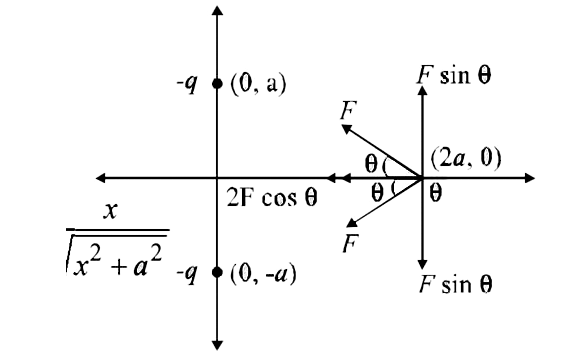Two equal negative charges −q are fixed at points (0,−a) and (0,a) on y-axis. A poistive charge Q is released from rest at point (2a,0) on the x-axis. The charge Q will
(a) execute simple harmonic motion about the origin
(b) move to the origin remain at rest
(c) move to infinity
(d) execute oscillatory but not simple harmonic motion
The correct Answer is:D
Let us consider the positive charge Q at any instant of time t at a distance x from the origin. It is under the influence of two forces vedF1(=F) and →F2(=F). On resolving these two forces we find that Fsinθ cancels out. The resultant force is

FR=2Fcosθ
=2×kQq(x2+a2)×x√x2+a2
=2kQqx(x2+a2)3/2
Since FR is not proportional to x, the motion is NOT simple harmonic. The charge Q will accelerate till the origin and gain velocity. At the origin the net force is zero but due to momentum it will cross the origin and more towards left. As it comes on negative x-axis, the force is again towards the origin.
Topper's Solved these Questions
- ELECTROSTATICSBOOK - SUNIL BATRA (41 YEARS IITJEE PHYSICS)CHAPTER - ELECTROSTATICSEXERCISE - Subjective Problems
2 Videos
- ELECTROSTATICSBOOK - SUNIL BATRA (41 YEARS IITJEE PHYSICS)CHAPTER - ELECTROSTATICSEXERCISE - Comprehension Based Questions
2 Videos
- ELECTROMAGNETIC INDUCTION AND ALTERNATING CURRENTBOOK - SUNIL BATRA (41 YEARS IITJEE PHYSICS)CHAPTER - ELECTROMAGNETIC INDUCTION AND ALTERNATING CURRENTEXERCISE - JEE Main And Advanced
107 Videos
- MODERN PHYSICSBOOK - SUNIL BATRA (41 YEARS IITJEE PHYSICS)CHAPTER - MODERN PHYSICSEXERCISE - MCQ (One Correct Answer
1 Videos
Similar Questions
Two equal positive charges , Q , are fixed at points (0,d) and (0,−d) on the y-axis. A charged particle having charge −q and mass m is released from rest at point (d,0) on the x-axis . Discuss the motion of charged particle.
View SolutionConsider a system of two equal points charges, each Q=8μC, which are fixed at points (2m, 0 ) and (-2m, 0). Another charge μ is held at a point (0,0.1m) on the y-axis. Mass of the charge μ is 91 mg . At t= 0 , μ is released from rest and it is observed to oscillate along y-axis in a simple harmonic manner. It is also observed that at t = 0 , the force experienced by it is 9×10−3N.
Charge q is
View Solution
Knowledge Check
When charge is given to a soap bubble, it shows:Two equal negative charges -q are fixed fixed at point (0, -a) and (0,a) on y-axis. A positive charge Q is released from rest at the point (2a, 0) on the x-axis. The charge Q will:
Aan increase in sizeBsometimes an increase and sometimes a decrease in sizeCno change in sizeDnone of theseTwo equal negative charges are fixed at points and on y-axis. A positive charge Q is released from rest at the point on the x-axis. The charge Q will:
Aexecute simple harmonic motion about the originBmove to the origin and remain at restCmove to infinityDsame as at point 25 cm aways form the surfaceTwo equal positive charges Q are fixed at points (a, 0) and (−a,0) on the x-axis. An opposite charge -q at rest is relased from point (0, a) on the y-axis. The charge -q will
AMove to infinityBMove to origin and rest thereCUndergo SHM about the originDExecute oscillatory motion but not SHM
Consider a system of two equal points charges, each Q=8μC, which are fixed at points (2m, 0 ) and (-2m, 0). Another charge μ is held at a point (0,0.1m) on the y-axis. Mass of the charge μ is 91 mg . At t= 0 , μ is released from rest and it is observed to oscillate along y-axis in a simple harmonic manner. It is also observed that at t = 0 , the force experienced by it is 9×10−3N.
Frequency of oscillation is
View SolutionConsider a system of two equal points charges, each Q=8μC, which are fixed at points (2m, 0 ) and (-2m, 0). Another charge μ is held at a point (0,0.1m) on the y-axis. Mass of the charge μ is 91 mg . At t= 0 , μ is released from rest and it is observed to oscillate along y-axis in a simple harmonic manner. It is also observed that at t = 0 , the force experienced by it is 9×10−3N.
Amplitude of motion is
View SolutionConsider a system of two equal points charges, each Q=8μC, which are fixed at points (2m, 0 ) and (-2m, 0). Another charge μ is held at a point (0,0.1m) on the y-axis. Mass of the charge μ is 91 mg . At t= 0 , μ is released from rest and it is observed to oscillate along y-axis in a simple harmonic manner. It is also observed that at t = 0 , the force experienced by it is 9×10−3N.
Equation of SHM (displacement from mean position) can be expressed as
View SolutionTwo charges q and -q are placed at ( a,0) and (−a,0) on the x-axis. Another charge 2q is taken from ( 0,0) to ( 0,a) , then the work done to do so
View SolutionTwo point charges −q and +q are located at points (0,0−a) and (0,0,a) resepctively.The electric potential at point (0,0,z)is (Z>a)
View Solution
